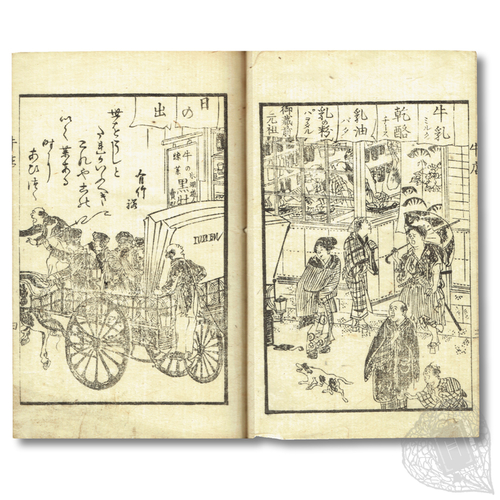Classic Illustrated Books Modern Art and Design Books Translations of Western Texts Japanese Literature Prints and Ephemera Western Books Photo Books Paintings & Scrolls Australia & New Zealand Others
Australia New Zealand Antarctica Japan Korea China Other
Edo Period [1603-1853] Bakumatsu Period [1853-1868] Meiji Period [1868-1912] Taishō Period [1912-1926] Shōwa Period [1926-1989]
Share this book on...

Ushiya Zōdan Aguranabe: Ichimei Doronken (Beef-Shop Small-Talk: Cross-Legged (at a Beef) Pot)
 ENQUIRE ENQUIRE |
Ushiya Zōdan Aguranabe: Ichimei Doronken ["Beef-Shop Small-Talk: Cross-Legged (at a Beef) Pot"]
Kanagaki, Robun [text by]; Ikkeisai [Utagawa], Yoshiiku [illustrated by].
Tōkyō: Seishidō, [preface dated Meiji 4 (1871)].
The shohen (first series) of Robun's famous satire on the perceived sophistication of Western customs. In the work, he ridicules characters who argue that the (Western) custom of eating beef introduced to Japan is 'civilised'. Sharalyn Orbaugh (2007) suggests that, "Although nutrition was the basis of the original promotion of beef by educator and statesman Fukuzawa Yukichi, its concurrent power as a metaphor for cultural control of the natural world is apparent in Kanagaki Robun's story Aguranabe (Sitting around the stew pot, 1871)", adding that "Robun is mocking those Japanese who have rushed to embrace the new Western fads, and the speeches of his characters reveal the implicit connections between the meaty contents of the 'stew pot' and the larger implications of modernization". Richard Reitan (2009) notes that:
"This satirical account of eating beef (formerly discouraged in Buddhist thought as unclean, but here described as "such a clean thing") exemplifies a possible means of deflecting the universalization of civilized practice. The beefeater, even as he spoke of "unenlightened boors," "savages," and "barbaric superstitions," was himself made to appear foolish. In this way, Robun brings civilized conduct and foolishness together, collapsing the opposition upon which the advocates of civilization relied."
A total of three series (in five volumes) were published, with Kyōsai illustrating the first volume of the third series. The title has alternatively been rendered into English as Kettle of Peaceful and Simple Pleasures and Sitting Cross-Legged at the Beef Pot. A scarce copy of the first series from one of Robun's best-known works.
First series. One four-hole-bound (yotsumetoji) volume, complete, on double leaves, traditional East Asian binding style (fukurotoji). Original wrappers creased, stain to foot, ex-ownership inscription to lower. Ex-ownership inscriptions and stamp to upper pastedown. Light occasional creases, browning, and light stains internally. 26, [1] leaves. 18.6 x 12.4 cm.
❧ Orbaugh, Sharalyn. Japanese Fiction of the Allied Occupation: Vision, Embodiment, Identity. Leiden: Brill, 2007.
❧ Reitan, Richard. Making a Moral Society: Ethics and the State in Meiji Japan. Honolulu: University of Hawai’i Press, 2010.
# 240203-45


• Ask a question about this item >
Classic Illustrated Books Modern Art and Design Books Translations of Western Texts Japanese Literature Prints and Ephemera Western Books Photo Books Paintings & Scrolls Australia & New Zealand Others
Australia New Zealand Antarctica Japan Korea China Other
Edo Period [1603-1853] Bakumatsu Period [1853-1868] Meiji Period [1868-1912] Taishō Period [1912-1926] Shōwa Period [1926-1989]
Share this book on...













